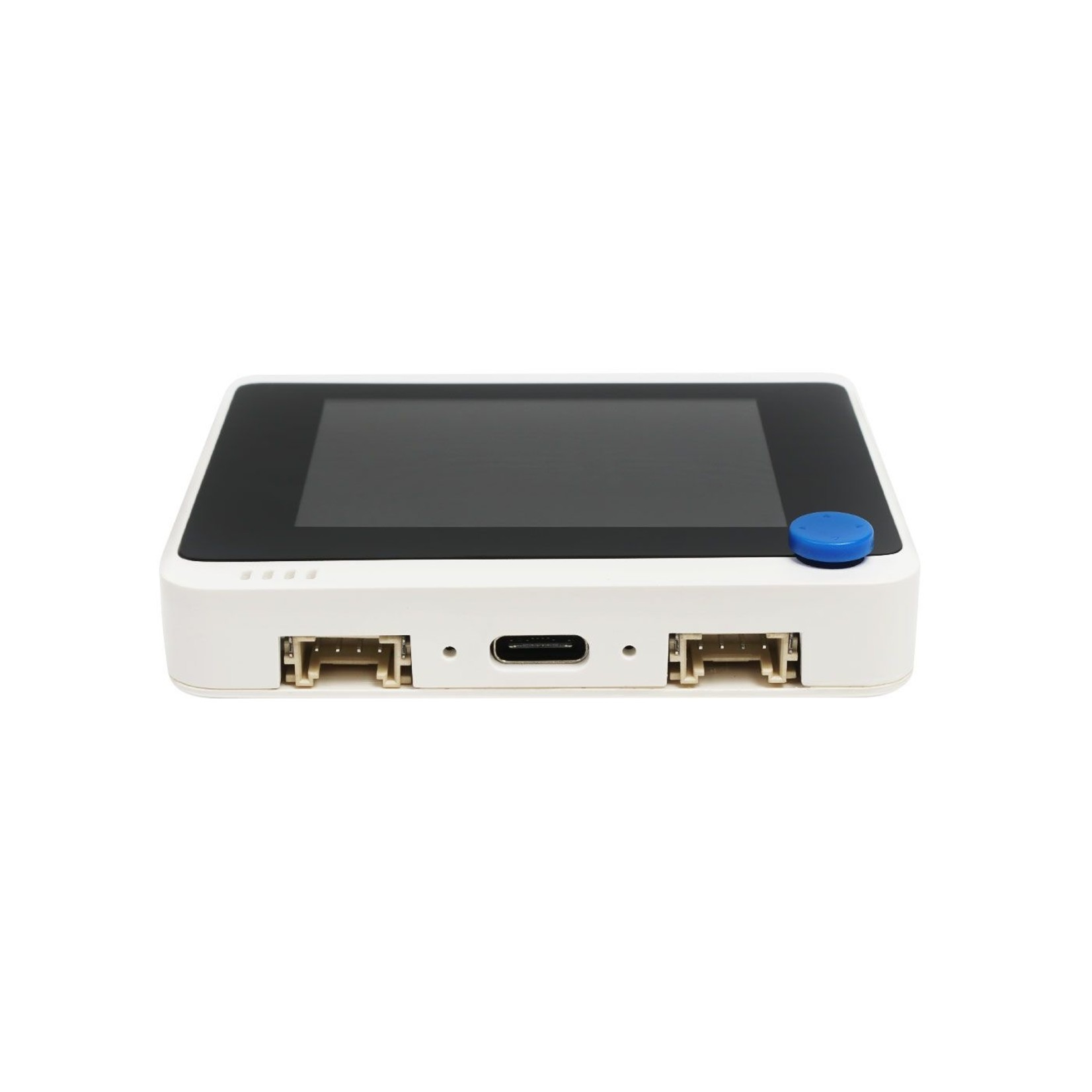Key Features
- Powerful MCU: Microchip ATSAMD51P19 with ARM Cortex-M4F core running at 120MHz
- Reliable Wireless Connectivity: Equipped with Realtek RTL8720DN, dual-band 2.4GHz / 5GHz Wi-Fi (supported only by Arduino)
- Highly Integrated Design: 2.4” LCD Screen, IMU and more practical add-ons housed in a compact enclosure with built-in magnets & mounting holes
- Raspberry Pi 40-pin Compatible GPIO
- Compatible with over 300 plug&play Grove modules to explore with IoT
- USB OTG Support
- Support Arduino, CircuitPython, Micropython, ArduPy, AT Firmware, Visual Studio Code
- Perfect device for experimenting and prototyping TinyML applications.
- TELEC certificated
Description
The Wio (Wireless Input and Output) platform (Wio Link, Wio Nodes,etc.) was first introduced to the world at the end of 2015 by Seeed.
Today a new Wio member is joining the family - Wio Terminal. Instead of being a single embedded functional module, Wio Terminal is more of a complete system equipped with Screen + Development Board + Input/Output Interface + Enclosure, making it an efficient and Product-Ready Product.
Applications
- Sense and tag the Real-World data with over 300 Groves created by Seeed
- Easily build your TinyML applications with Edge Impulse
- Use 100% open-source Hardware in a pythonic way
- Build your program interpreter starting from 90% with an LCD screen and compact enclosure
- Play with Raspberry Pi
- Support Arduino/MicroPython
- Gaming development platform
- Wio Terminal + Grove = IoT System
- Wio Terminal + Raspberry Pi = Edge Computing System
- Wio Terminal + Customized add-ons = Handheld devices or endless possibilities!
Highlight Features
Highly Integrated Design
- MCU, LCD, WIFI, BT, IMU, Microphone, Buzzer, microSD Card, Configurable Buttons, Light Sensor, 5-Way Switch, Infrared Emitter (IR 940nm), Crypto-authentication Ready
- Well-designed enclosure with built-in magnets and two mounting holes, allowing you to set up your IoT project without hassle
Powerful MCU - Microchip ATSAMD51P19
- ARM Cortex-M4F core running at 120MHz (Boost up to 200MHz)
- 4 MB External Flash, 192 KB RAM
- Comprehensive Protocol Support
- SPI, I2C, I2S, ADC, DAC, PWM, UART(Serial)
Reliable Wireless Connectivity (supported only by Arduino)
- Powered by Realtek RTL8720DN
- Dual Band 2.4Ghz / 5Ghz Wi-Fi (802.11 a/b/g/n)
- BLE / BLE 5.0
USB OTG Support
- Accessible Devices(as USB-Host): read data or signals from a mouse, keyboard, MIDI devices, Xbox/PS gaming controllers, 3D printers
- Simulated Devices(as USB-Client): emulate a mouse, keyboard or MIDI devices to Host PC
- When using USB Host/Client function, you can use the 40-pin on the back of Wio Terminal for power supply. Check here for detailed instructions.
Grove Ecosystem
- 300+ Grove modules to explore with IoT
- Two onboard multi-functional Grove ports can be used for Digital, Analog, I2C, and PWM
- Note: To connect Grove with Wio Terminal, please use unbuckled grove cable.
Raspberry Pi 40-pin Compatible
- Can be mounted to a Raspberry Pi as a slave device
- Raspberry Pi's HAT can be used with an adapter cable
Ready for Embedded Machine Learning
- By utilizing Wio Terminal and Edge Impulse, we can "teach old sensors new tricks"
Azure Certified
Software Support
- Arduino
- MicroPython
- ArduPy
- AT Firmware
- Visual Studio Code
- CircuitPython
Wio Terminal Classroom
In this show, our engineer Lakshantha will explain how to use Wio terminal along with the software and present you fun demos as well! In this episode, you will learn about how to draw text strings by using the coordinate system and will learn to display "Hello World!" at the end of the video!
Setup, Documentation, and Support
Please visit our wiki for more information about Wio Terminal.
Technical Specifications
|
Main Chip
|
Manufacturer Part Number
|
ATSAMD51P19
|
|
Core Processor
|
ARM® Cortex®-M4F
|
|
Maximum Speed
|
200MHz
|
|
External Flash
|
4MBytes
|
|
Operating Temperature
|
-40°C ~ 85°C (TA)
|
|
LCD Screen
|
Resolution
|
320x240
|
|
Display Size
|
2.4inch
|
|
Drive IC
|
ILI9341
|
|
Wireless Connectivity
|
Manufacturer Part Number
|
RTL8720DN
|
|
KM4 CPU
|
ARM® Cortex®-M4F @ 200MHz
|
|
KM0 CPU
|
ARM® Cortex®-M0
|
|
Wi-Fi
|
802.11 a/b/g/n 1x1, 2.4GHz & 5GHz
|
|
Bluetooth
|
Support BLE5.0
|
|
Built-in Modules
|
Accelerometer
|
LIS3DHTR
|
|
Microphone
|
1.0V-10V -42dB
|
|
Speaker
|
≥78dB @10cm 4000Hz
|
|
Light Sensor
|
400-1050nm
|
|
Infrared Emitter
|
940nm
|
|
Interface
|
MicroSD Card Slot
|
Maximum 16GB
|
|
GPIO
|
40-PIN (Raspberry Pi Compatible)
|
|
Grove
|
2 (Multifunction)
|
|
FPC
|
20-Pins
|
|
USB Type-C
|
Power & USB-OTG
|
|
Operation Interface
|
5-Way Switch
|
|
|
Power/Reset Switch
|
|
|
User-defined button *3
|
|
|
Enclosure
|
Dimension
|
72mm*57mm*12mm
|
|
Materials
|
ABS+PC
|
Part List
- Wio Terminal
- USB Type-C Short Cable
- User Manual










